Frank Corso
Genre: Impressionist
Medium: Oil on canvas
Gallery: Gardner Colby Gallery
Website: www.frankcorso.com
Facebook: no
His Art
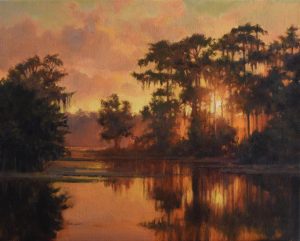 Gardner Colby owner Nancy Winch told American Art Collector magazine in 2007: “In his ten years of painting here in Naples, Frank Corso has firmly established himself as the preeminent interpreter of the Florida landscape. It is my firm belief that when the pundits look back and discuss the greatest landscape painters of the 20th and 21st centuries, Frank Corso’s name will be on that list.”
Gardner Colby owner Nancy Winch told American Art Collector magazine in 2007: “In his ten years of painting here in Naples, Frank Corso has firmly established himself as the preeminent interpreter of the Florida landscape. It is my firm belief that when the pundits look back and discuss the greatest landscape painters of the 20th and 21st centuries, Frank Corso’s name will be on that list.”
Corso’s genre is impressionism. His motifs are balmy beach scenes, 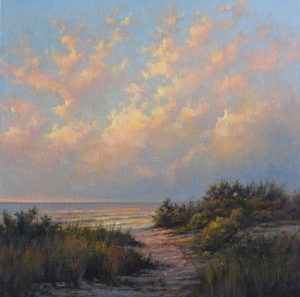 torrid Gladescapes and nocturnal settings with luminous skies. His forte is his exceptional treatment of light, a quality that Corso attributes to his steadfast refusal to rely on photographs or work inside, under artificial light. “I rarely use photographs, even as a memory jog,” Corso fiercely states. “I work on location and paint what I see.” He finishes his smaller paintings in one sitting, so there’s no need for photos in connection with them. “Even on the larger works, I do most of the work while I’m on location though it’s usually necessary
torrid Gladescapes and nocturnal settings with luminous skies. His forte is his exceptional treatment of light, a quality that Corso attributes to his steadfast refusal to rely on photographs or work inside, under artificial light. “I rarely use photographs, even as a memory jog,” Corso fiercely states. “I work on location and paint what I see.” He finishes his smaller paintings in one sitting, so there’s no need for photos in connection with them. “Even on the larger works, I do most of the work while I’m on location though it’s usually necessary 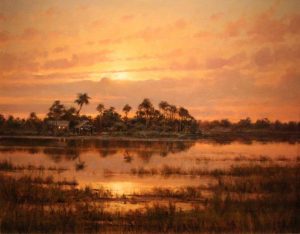 for me to complete them back in the studio because I run out of time.” And light.
for me to complete them back in the studio because I run out of time.” And light.
Painting what he sees in plein air infuses Corso’s paintings with reality you simply cannot get from a photograph. “When you paint from a photograph, the painting looks like a photograph,” Corso insists. Particularly a painting that’s impressionistic.
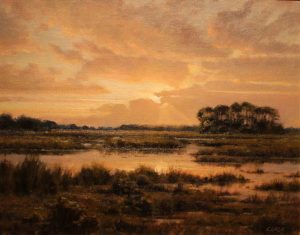 “I like the feel you get when you paint what you see.” And Corso goes to great lengths to paint what he sees.
“I like the feel you get when you paint what you see.” And Corso goes to great lengths to paint what he sees.
“I will continue to spend as much time as possible painting outdoors,” the artist posts on his website, “as I am convinced there is no better way to sharpen your skills as a designer and draftsman than to work from life. I actually hear other artists talk of their work as if it were tedious or boring, and in almost every case, 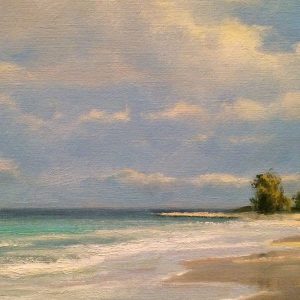 that is an artist who works indoors. The answers to nearly everything in painting landscape is outdoors. There is no substitute to painting from life, and there is certainly no better art director than Mother Nature. The artist’s studio is a good place to ponder what you did outdoors. I have been and will continue to paint the bulk of my paintings from life. Not to mention that being outside is a heck of a lot more fun.” Heat, humidity and mosquitoes be damned.
that is an artist who works indoors. The answers to nearly everything in painting landscape is outdoors. There is no substitute to painting from life, and there is certainly no better art director than Mother Nature. The artist’s studio is a good place to ponder what you did outdoors. I have been and will continue to paint the bulk of my paintings from life. Not to mention that being outside is a heck of a lot more fun.” Heat, humidity and mosquitoes be damned.
Plein air painting in the tradition of Claude Monet
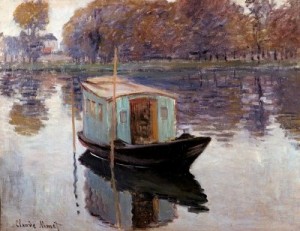 In 1874, Claude Monet decided to abandon his studio forever and only paint in plein air, in front of his motif. He bought a flat-bottomed wherry and had a carpenter construct a tall cabin where he could paint sheltered from the sun, rain and cold. A separate area at the back was covered with a striped awning. He painted from this floating studio during his time in Argenteuil, Vétheuil and Poissy. He may have even taken it with him to
In 1874, Claude Monet decided to abandon his studio forever and only paint in plein air, in front of his motif. He bought a flat-bottomed wherry and had a carpenter construct a tall cabin where he could paint sheltered from the sun, rain and cold. A separate area at the back was covered with a striped awning. He painted from this floating studio during his time in Argenteuil, Vétheuil and Poissy. He may have even taken it with him to 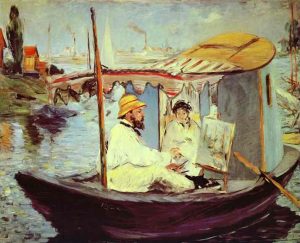 Giverny.
Giverny.
The wherry enabled Monet to explore the moods and the effects of light on the river scenery. So inspired was his contemporary, Edouard Manet, that he painted Claude working in his boat. The painting now hangs in the Neue Pinakothek in Munich, where it continues to inspire modern day impressionists to paint en plein air.
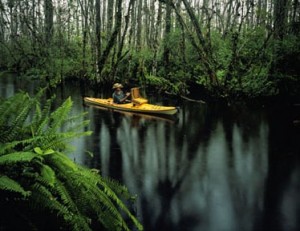 Following Monet’s example, impressionist Frank Corso uses a specially-rigged kayak as a floating outdoor art studio. The kayak lets him maneuver through the mangroves and mazes of waterways that are part of the Everglades. “I paint from the kayak,” Corso told American Art Collector magazine for their February 2007 feature story (Vol. 16), “and am able to go down little rivers, drag an anchor and start painting on an easel I have bungee-chorded to the kayak.”
Following Monet’s example, impressionist Frank Corso uses a specially-rigged kayak as a floating outdoor art studio. The kayak lets him maneuver through the mangroves and mazes of waterways that are part of the Everglades. “I paint from the kayak,” Corso told American Art Collector magazine for their February 2007 feature story (Vol. 16), “and am able to go down little rivers, drag an anchor and start painting on an easel I have bungee-chorded to the kayak.”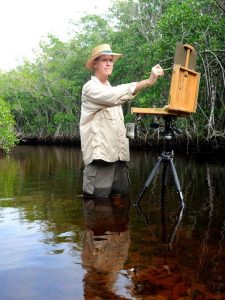 “It was just something that happened,” Corso recalls. “It wasn’t anything I really planned.” It was an evolution. At first, he packed up his paints and worked from the side of the road. Then, he paid a tour boat captain to take him out, drop him off and return for him hours later. Sometimes he hiked or biked into the Everglades. And then he hit on the idea of using a kayak. It took a bit of experimentation, but he finally found just the right kayak to accommodate his plein air painting. “It allows me to paint quite comfortably from just a couple of feet above the water, which gives everything – reeds, trees and even the skies – a unique perspective.” More grounded. As though seen through the eyes of the fauna who claim the Everglades as their habitat.
“It was just something that happened,” Corso recalls. “It wasn’t anything I really planned.” It was an evolution. At first, he packed up his paints and worked from the side of the road. Then, he paid a tour boat captain to take him out, drop him off and return for him hours later. Sometimes he hiked or biked into the Everglades. And then he hit on the idea of using a kayak. It took a bit of experimentation, but he finally found just the right kayak to accommodate his plein air painting. “It allows me to paint quite comfortably from just a couple of feet above the water, which gives everything – reeds, trees and even the skies – a unique perspective.” More grounded. As though seen through the eyes of the fauna who claim the Everglades as their habitat.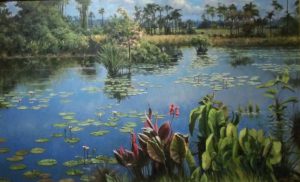 That ground level perspective informs his lily pad paintings (a motif made famous by Claude Monet). “The kayak gives me a unique perspective,” Corso explains. “If you’re standing on the bank looking down, it’s just a confused jumble. But at water level, each individual lily and pad stands out on its own.” Thus, in a picture like Lily Patterns (right), the tender
That ground level perspective informs his lily pad paintings (a motif made famous by Claude Monet). “The kayak gives me a unique perspective,” Corso explains. “If you’re standing on the bank looking down, it’s just a confused jumble. But at water level, each individual lily and pad stands out on its own.” Thus, in a picture like Lily Patterns (right), the tender 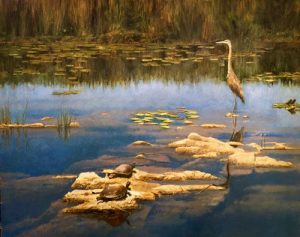 pink blooms rise majestically from their pads and poke their heads above the placid surface of the River of Grass, the nickname given to the Everglades because of the way the water causes the billions of blades of sawgrass to undulate in the current. “That’s something people don’t realize about the Everglades. The water’s always moving.”
pink blooms rise majestically from their pads and poke their heads above the placid surface of the River of Grass, the nickname given to the Everglades because of the way the water causes the billions of blades of sawgrass to undulate in the current. “That’s something people don’t realize about the Everglades. The water’s always moving.”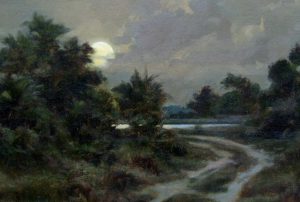 permits him to capture twilight and night scenes.
permits him to capture twilight and night scenes.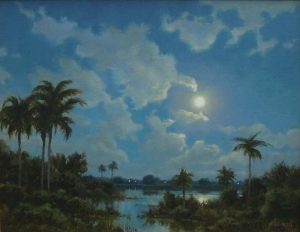 colors exactly right.” But painting outdoors after dark is even more critical. “What happens is that with no artificial light, your eyes open to the darkness and you see more and more.” Or as Corso told American Art Collector, “The great thing about painting with the moonlight, is that it’s so bright you can paint with no assisted light and it’s surprising at how accurate you can be.”
colors exactly right.” But painting outdoors after dark is even more critical. “What happens is that with no artificial light, your eyes open to the darkness and you see more and more.” Or as Corso told American Art Collector, “The great thing about painting with the moonlight, is that it’s so bright you can paint with no assisted light and it’s surprising at how accurate you can be.”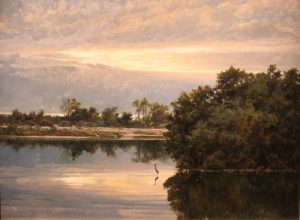 It takes a man with tremendous self-confidence to venture alone deep inside a swamp that’s home to gators, pythons, boar and myriad other predators. Corso does it with alacrity because that’s where he finds the best material for the landscapes and lily gardens for which he has become so well known.
It takes a man with tremendous self-confidence to venture alone deep inside a swamp that’s home to gators, pythons, boar and myriad other predators. Corso does it with alacrity because that’s where he finds the best material for the landscapes and lily gardens for which he has become so well known.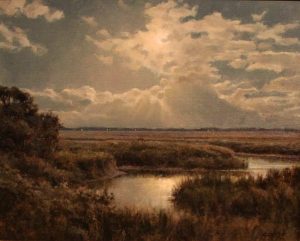 pythons that seem to be taking over habitats deep inside the Everglades. And gators benevolently mind their own business. “But I did have a scary moment with some wild boars one time,” Corso relates. “I was on land and came upon six boars. They started grunting and when I looked around, there wasn’t even a tree for me to climb.” Did he toss his canvas and box of oils on the ground and run for his kayak? Not Frank Corso. He stared them down.
pythons that seem to be taking over habitats deep inside the Everglades. And gators benevolently mind their own business. “But I did have a scary moment with some wild boars one time,” Corso relates. “I was on land and came upon six boars. They started grunting and when I looked around, there wasn’t even a tree for me to climb.” Did he toss his canvas and box of oils on the ground and run for his kayak? Not Frank Corso. He stared them down.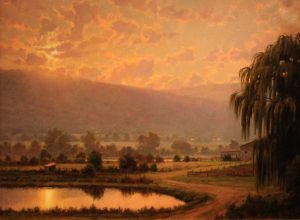 Corso expressed an early interest in art, and his talent was nurtured by his high school art teachers, George Benedict and Nick Todisco, who are fine artists in their own right. After attending both Onondaga Community College and Syracuse University, he embarked upon private study in both portraiture and figurative painting with Robert Hoffmann, an Austrian born portraitist. The association lasted more than 11 years.
Corso expressed an early interest in art, and his talent was nurtured by his high school art teachers, George Benedict and Nick Todisco, who are fine artists in their own right. After attending both Onondaga Community College and Syracuse University, he embarked upon private study in both portraiture and figurative painting with Robert Hoffmann, an Austrian born portraitist. The association lasted more than 11 years.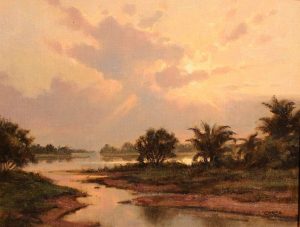 The artist then traveled extensively around the country and in Europe, spending the majority of his time in Italy. Over that span, he studied with other portrait painters, including Daniel Green in New York and Jack Callahan in Rockport. It wasn’t that Corso intended to establish himself as a portrait painter. Rather, he felt that the techniques he learned painting portraits could enable him to forge his own style in his preferred genre, landscape painting.
The artist then traveled extensively around the country and in Europe, spending the majority of his time in Italy. Over that span, he studied with other portrait painters, including Daniel Green in New York and Jack Callahan in Rockport. It wasn’t that Corso intended to establish himself as a portrait painter. Rather, he felt that the techniques he learned painting portraits could enable him to forge his own style in his preferred genre, landscape painting.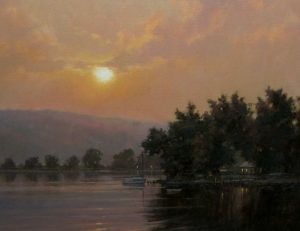 In the ’80s, Corso settled along the north shore of Massachusetts, where there has traditionally been a thriving art scene. He achieved master status at the Copley Society in Boston and earned numerous other awards, including The Yankee Sagendorf and the Grumbacher medal. Several of his paintings were even included in two Rockport Publishing hardcover art books, The Best of Oil Painting and Best of Pastels. His time there was fortuitous in another respect. It’s where he
In the ’80s, Corso settled along the north shore of Massachusetts, where there has traditionally been a thriving art scene. He achieved master status at the Copley Society in Boston and earned numerous other awards, including The Yankee Sagendorf and the Grumbacher medal. Several of his paintings were even included in two Rockport Publishing hardcover art books, The Best of Oil Painting and Best of Pastels. His time there was fortuitous in another respect. It’s where he 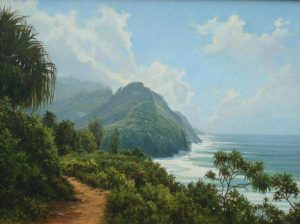 met Gardner Colby owner Nancy Winch, who maintained her gallery in Massachusetts at the time.
met Gardner Colby owner Nancy Winch, who maintained her gallery in Massachusetts at the time.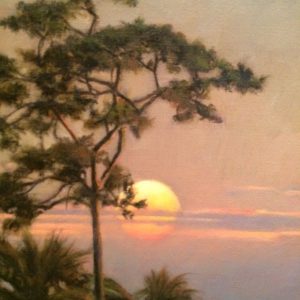 favorite motifs these days, beach scenes along the gulf coast and Everglades landscapes and nocturnal settings. His work continues to garner accolades. His paintings have not only been featured in American Art Collector magazine (vol. 16, February 2007), but in Sea History Magazine and Southwest Florida’s Expressions. Even during the prevailing recessionary economy, he continues to enjoy sell-out solo exhibitions in both Nantucket, Massachusetts and Naples, Florida.
favorite motifs these days, beach scenes along the gulf coast and Everglades landscapes and nocturnal settings. His work continues to garner accolades. His paintings have not only been featured in American Art Collector magazine (vol. 16, February 2007), but in Sea History Magazine and Southwest Florida’s Expressions. Even during the prevailing recessionary economy, he continues to enjoy sell-out solo exhibitions in both Nantucket, Massachusetts and Naples, Florida.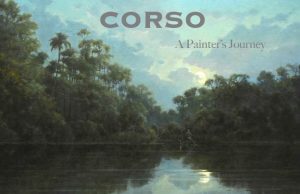 Corso is also a professional Blues and old time musician.
Corso is also a professional Blues and old time musician.- He is part of a trio who play under the name Spoonful.
- He has released three CDs with his band Roll and Tumble, and a solo CD featuring guitar, slide guitar, banjo and ukulele.
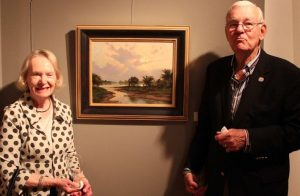 Corso also builds his own guitars and banjos.
Corso also builds his own guitars and banjos.- He has also restored and maintains his award winning 1933 Plymouth coupe which, to date, has garnered 17 national trophies.
- He is also constantly tinkering with his 2008 C6 ZO6 Corvette.
- 2012 represents his 15th solo show at Naples’ Gardner Colby Gallery.
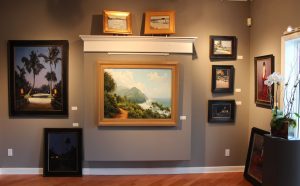 His paintings are sought by collectors and hang in many private and corporate institutions around the world including the Ritz Carlton, Naples Florida, The Cloister, Geogia Sea Island and many others.
His paintings are sought by collectors and hang in many private and corporate institutions around the world including the Ritz Carlton, Naples Florida, The Cloister, Geogia Sea Island and many others.- Several of Corso’s paintings were included on the set of The Company Men, a major motion picture starring Kevin Costner, Ben Affleck and Tommy Lee Jones.
Last updated 2/14/18.













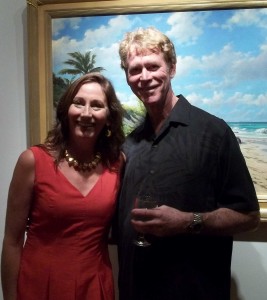

 Tom Hall is both an amateur artist and aspiring novelist who writes art quest thrillers. He is in the final stages of completing his debut novel titled "Art Detective," a story that fictionalizes the discovery of the fabled billion-dollar Impressionist collection of Parisian art dealer Josse Bernheim-Jeune, thought by many to have perished during World War II when the collection's hiding place, Castle de Rastignac in southern France, was destroyed by the Wehrmacht in reprisal for attacks made by members of the Resistance operating in the area. A former tax attorney, Tom holds a bachelor's degree as well as both a juris doctorate and masters of laws in taxation from the University of Florida. Tom lives in Estero, Florida with his fiancee, Connie, and their four cats.
Tom Hall is both an amateur artist and aspiring novelist who writes art quest thrillers. He is in the final stages of completing his debut novel titled "Art Detective," a story that fictionalizes the discovery of the fabled billion-dollar Impressionist collection of Parisian art dealer Josse Bernheim-Jeune, thought by many to have perished during World War II when the collection's hiding place, Castle de Rastignac in southern France, was destroyed by the Wehrmacht in reprisal for attacks made by members of the Resistance operating in the area. A former tax attorney, Tom holds a bachelor's degree as well as both a juris doctorate and masters of laws in taxation from the University of Florida. Tom lives in Estero, Florida with his fiancee, Connie, and their four cats.